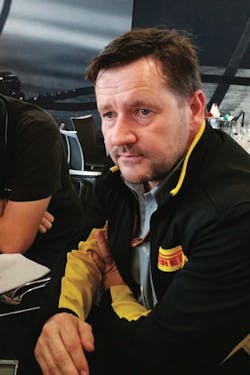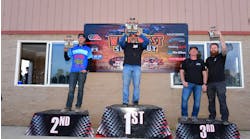When F1 racing returned to Mexico City for the first time since 1992, Tom Gravalos, CEO of Pirelli Neumáticos de México, S.A. de C.V., rolled out the red carpet for dealers from across all the Americas.
In total, about 530 folks were treated to a weekend of hospitality and racing by the company that says, “We are the number one motorsport tire supplier in the world,” according to its Motorsport Director Paul Hembery.
There is no question that Pirelli uses racing as its main marketing tool and this race was one example of what the company is attempting to do.
MTD was on-hand for the event and had a chance to talk with Hembery on a wide range of topics. He says the company brings about 1,800 tires to each F1 race, with all of the tires being produced primarily in Pirelli’s Turkey plant, although some tires are produced in a Romanian factory.
A new ultra-soft compound tire is in the works for slower tracks in 2016 — Monaco, Canada, Singapore and perhaps Mexico, and significant changes will be coming after that as rules take a rather dramatic change starting in 2017. Hembery would like to see more on-track testing to help with tire development, but is pleased with what has been done in the lab to duplicate track conditions.
In 2017, Hembery says the cars will be running four to five seconds faster at most circuits, with the majority of the increase in speed coming from improvements in cornering which will put higher loads on the tires.
As it relates to the marketing benefits of racing, Hembery believes that F1 is “well-known in the U.S.” But, he feels there needs to be at least three races in the country, mentioning California as a possible second venue and alluding to the need on the East Coast “for the sport to grow in the U.S.”
F1 races averaged 535,000 TV viewers in the U.S. during 2015, according to Sports Media Watch, up 14% from the comparable point last year (471K). As a comparison, the same company shows Monday Night Football games averaging between 12.2 million and 14.5 million viewers each week.
Hembery thinks that Pirelli’s target customers in the U.S. are being reached through their F1 program, but says, “Who wants to watch races in the middle of the night?” He knows that the timing of races is scheduled for European television, but suggests “a few fundamentals could be changed to grow the sport in the U.S.”
To further help viewership, Hembery believes more continuity is in order. “We could run 10 races in a row, take a break, and then run 10 more.” He acknowledges that NASCAR’s approach to promotion works quite well.
In total, Hembery says there are more than 400 racing series’ championships, when including motorcycles, too. Some of the series are “spec tire” series — like F1 and NASCAR — which use only one brand of tire, while others are competitive.
Hembery weighed in on the pros and cons for each type of motorsport. When it is open competition, each company can show its technological strengths and feel great about winning. However, “Even when you are on the winning car, it’s hard to persuade the public that you’ve made an active contribution to the winner.
“When somebody wins, it’s the car and the driver, but when they lose, it’s the fault of the tire,” says Hembery.
In a spec series, particularly with an elite series such as F1, “you are associated with the pinnacle of the sport” and that is important. And, (while laughing due to the expenses involved in F1), Hembery says that a spec tire series allows a tire company to have cost control.
The down side to a spec tire series is that “there is no championship trophy for tires. You must be realistic and recognize it is always the driver and then the car.” To illustrate the point, Hembery pointed out that in each F1 driver’s home country, the crowd roars approval for the driver — not the car, not the team — just the driver.
“The real heroes are the drivers, they drive interest. You can’t take a car on the red carpet at the Oscars.” ?





